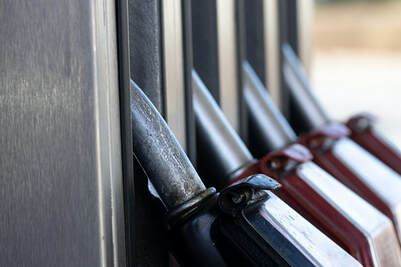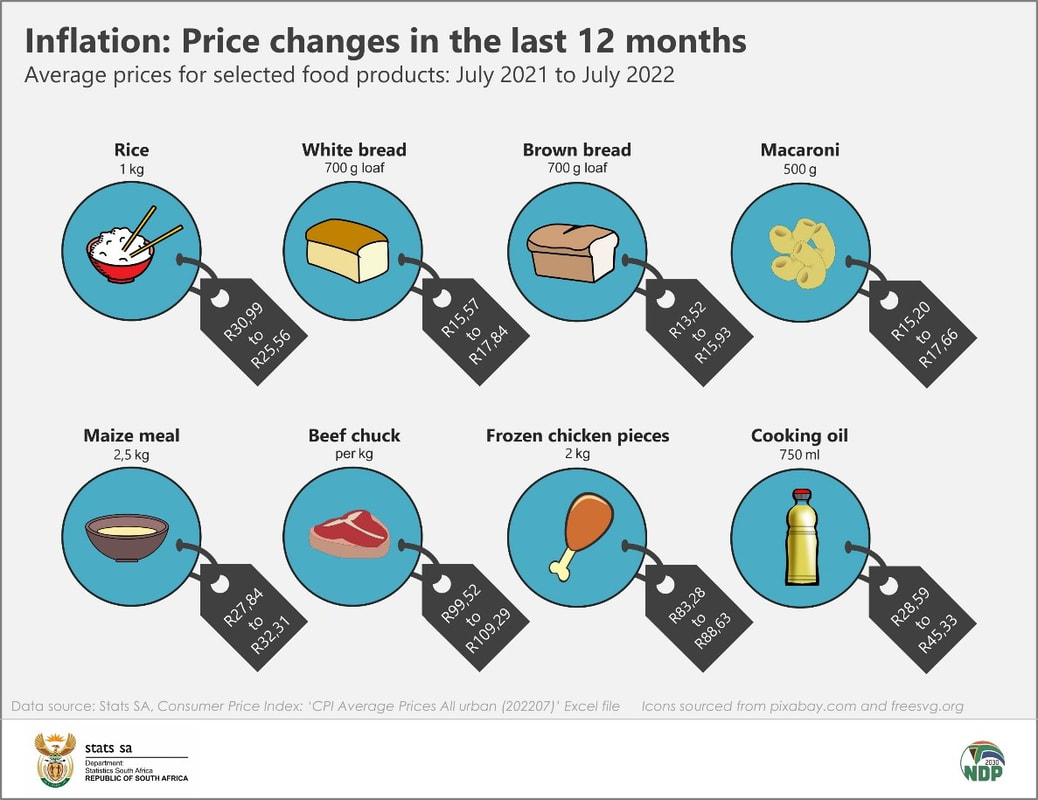South Africa's national statistics office announces that South Africa's inflation rate hit a 13 year high at 7.8%
Category: Economics, Inflation, Cost of living
Date: 25 August 2022
Date: 25 August 2022
|
South Africa's, annual consumer inflation reached another 13-year high, increasing to 7,8% in July 2022, pushing the inflation rate of South Africa to a 13 year high. And the main driver of South Africa's inflation rate at this point in time is the massive year on year increases in the fuel prices, which hit record levels in July 2022
|
Transport; food and non-alcoholic beverages (NAB); and housing and utilities continue to place upward pressure on the annual rate. Bread & cereals, oils & fats, fuel and electricity all made a notable impact on this month’s reading.
The consumer price index (CPI) jumped by 1,5% between June 2022 and July 2022 – only the fourth time since 2008 (i.e. since the beginning of the current CPI series) that the monthly increase was 1,5% or higher.
Consumers are feeling the pinch, particularly for non-durable goods – those items bought most frequently, such as food, drink, electricity, fuels, and medicine. Annual inflation for non-durable goods is in double-digit territory, at 14,4%. This is much higher than the rates recorded for durable goods (4,8%) and services (4,2%).
The annual rate for food and NAB was 9,7% in July, higher than the 8,6% reading in June. Bread & cereals inflation continues to quicken, with the annual rate rising to 13,7% from 11,2% in June; the monthly increase was 2,4% in July, with large monthly price increases recorded for maize meal (4,2%), cake flour (6,3%), macaroni (5,0%) and white bread (2,8%). Rice bucked the trend, with prices decreasing by 3,1%.
Oils & fats continue to register the highest annual rate of increase among food products, accelerating to 36,2% in July from 32,5% in June. There is much public interest in the impact of actual price increases on consumers. The graphic below shows the change in average prices, from July 2021 to July 2022, for a selection of commonly purchased food items
The consumer price index (CPI) jumped by 1,5% between June 2022 and July 2022 – only the fourth time since 2008 (i.e. since the beginning of the current CPI series) that the monthly increase was 1,5% or higher.
Consumers are feeling the pinch, particularly for non-durable goods – those items bought most frequently, such as food, drink, electricity, fuels, and medicine. Annual inflation for non-durable goods is in double-digit territory, at 14,4%. This is much higher than the rates recorded for durable goods (4,8%) and services (4,2%).
The annual rate for food and NAB was 9,7% in July, higher than the 8,6% reading in June. Bread & cereals inflation continues to quicken, with the annual rate rising to 13,7% from 11,2% in June; the monthly increase was 2,4% in July, with large monthly price increases recorded for maize meal (4,2%), cake flour (6,3%), macaroni (5,0%) and white bread (2,8%). Rice bucked the trend, with prices decreasing by 3,1%.
Oils & fats continue to register the highest annual rate of increase among food products, accelerating to 36,2% in July from 32,5% in June. There is much public interest in the impact of actual price increases on consumers. The graphic below shows the change in average prices, from July 2021 to July 2022, for a selection of commonly purchased food items
Municipalities increase service charges in July every year. Electricity tariffs increased on average by 7,5%, equivalent to the 7,5% benchmark approved by the National Energy Regulator of South Africa (NERSA). This increase is lower than last year’s rise of 13,8% but higher than the 2020 increase of 6,3%.
Together with the rise in electricity tariffs, consumers also had to deal with further fuel price increases. Transport costs were up by 4,8% between June and July, with fuel rising by 9,4%. Fuel is 56,2% more expensive than it was twelve months ago, with the price of a litre of inland 95-octane petrol rising from R17,39 in July 2021 to R26,74 in July 2022.1 The average price for diesel increased from R16,58 to R26,61 per litre over the same period.
Those relying on public transport didn’t escape the pain. Taxi fares jumped in July too, rising by 9,0% from June and taking the annual rate to 16,4%.
Together with the rise in electricity tariffs, consumers also had to deal with further fuel price increases. Transport costs were up by 4,8% between June and July, with fuel rising by 9,4%. Fuel is 56,2% more expensive than it was twelve months ago, with the price of a litre of inland 95-octane petrol rising from R17,39 in July 2021 to R26,74 in July 2022.1 The average price for diesel increased from R16,58 to R26,61 per litre over the same period.
Those relying on public transport didn’t escape the pain. Taxi fares jumped in July too, rising by 9,0% from June and taking the annual rate to 16,4%.
Inflation kept unchecked is one of, if not the biggest economic evil out there. Why? Well it erodes the buying power of money. The R100 you have now, is worth 7.8% less than it was a year ago. So essentially a R100 from a year ago, is now only worth R92.20. So if you want to buy the same goods you bought with a R100 last year this time you will need more than R100 as your R100 is now essentially only able to buy you goods that would have cost R92.20 last year.
And if left unchecked money becomes worth less and less, to the extent that its not even worth the paper its printed on. This is what happens in countries that has hyper inflation. Countries such as Venezuela and Zimbabwe. As money becomes worthless people start buying using barter (goods and services) in order to survive. While South Africa is far from that, it just shows what rampant inflation can do to countries.
With South Africa's inflation at a 13 year high we can be rest assured the South African Reserve Bank has a very steep interest rate hike its planning to make very soon. Buckle up folks. Surviving each money will just get harder and harder.
And if left unchecked money becomes worth less and less, to the extent that its not even worth the paper its printed on. This is what happens in countries that has hyper inflation. Countries such as Venezuela and Zimbabwe. As money becomes worthless people start buying using barter (goods and services) in order to survive. While South Africa is far from that, it just shows what rampant inflation can do to countries.
With South Africa's inflation at a 13 year high we can be rest assured the South African Reserve Bank has a very steep interest rate hike its planning to make very soon. Buckle up folks. Surviving each money will just get harder and harder.

